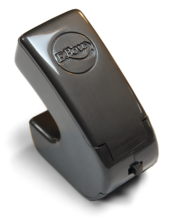EBow


The EBow, short for electronic bow or energy bow,[1] is an electronic device used for playing string instruments, most often the electric guitar. It is manufactured by Heet Sound Products, of Los Angeles, California. It was invented by Greg Heet in 1969, introduced in 1976 and patented in 1978.[2]
The EBow uses a pickup in an inductive string driver feedback circuit, including a sensor coil, driver coil and amplifier, to induce forced string vibrations. The EBow drives one string at a time, producing a sound reminiscent of using a bow on the strings.
History
[edit]The EBow was introduced in 1976 at NAMM, and has remained in continuous production since.[3][4] The first version was activated by plucking the guitar string. The second, introduced in 1983, added an on/off switch and a more powerful drive. The third, introduced in 1989, had improved sensitivity and faster attack. The latest version, the Ebow Plus, introduced in 1998, adds a blue LED and a switch to allow users to move between normal and harmonic modes (which sounds one octave higher).[4]
Function
[edit]The Ebow uses a pickup and a magnetic feedback circuit to vibrate strings without touching them. Whereas guitars traditionally have fast attack and slow release, meaning notes ring immediately and then fade out, the Ebow can sustain notes indefinitely and gives greater control over their attack and decay.[4]
Use
[edit]The Ebow was particularly popular in 1980s music, such as the acts Big Country, Tones on Tail, Love and Rockets and Bill Nelson.[4] The Love and Rockets guitarist Daniel Ash said the EBow "changed everything for me ... [it] basically turns the guitar into a keyboard ... It completely opened up the sound of the guitar."[5]
It has been used to create background textures, or sustained notes similar to guitar feedback, as in "(Don't Fear) The Reaper" (1976) by Blue Öyster Cult and "Heaven Beside You" (1996) by Alice in Chains.[4] In the 1990s, it was used by acts including the Red Hot Chili Peppers, Van Halen, Metallica and Foo Fighters.[4]
The EBow was prominently used by the Siouxsie and the Banshees guitarist John McGeoch on "Sin in My Heart", from the 1981 album Juju.[6] The EBow is used by the Radiohead guitarist Ed O'Brien for performances of songs such as "My Iron Lung", "Talk Show Host", "Jigsaw Falling Into Place", "Where I End and You Begin" and "Nude".[7]
In the 1980s the Bongos used the EBow in the intro of their song "Numbers With Wings" and also in "River To River", "Miss Jean", "Glow", "Flew A Falcon" and "Sweet Blue Cage". Frontman Richard Barone continues to use an EBow on his subsequent solo recordings and much of his production work including his songs "Love is a Wind that Screams" and his cover of T. Rex's "The Visit".[8]
References
[edit]- ^ "The Amazing EBow :: FAQ". Ebow.com. Retrieved 31 July 2015.
- ^ "String instrument vibration initiator and sustainer". Patents.google.com. Retrieved 15 March 2021.
- ^ Duxson, Eli (2024-02-15). "The story of the EBow in seven tracks". Mixdown Magazine. Retrieved 2024-08-24.
- ^ a b c d e f Gill, Chris (2023-05-04). "In praise of the EBow, one of the most under-appreciated yet influential guitar tools of all time". Guitar World. Retrieved 2024-08-24.
- ^ "There's Only One: An Interview with Daniel Ash". Collideartandculture.com. 16 May 2018. Retrieved 18 February 2023.
- ^ Sullivan-Burke, Rory (April 2022). The Light Pours Out of Me: The Authorised Biography of John McGeoch. Omnibus Press. p. 108. ISBN 978-1913172664.
- ^ Brewster, Will (2 June 2020). "The Story of the EBow in 7 Tracks". Mixdown. Retrieved 2020-09-27.
- ^ "From The Desk Of Richard Barone: My EBow And Me". Magnetmagazine.com. 9 October 2013. Retrieved 18 February 2023.
